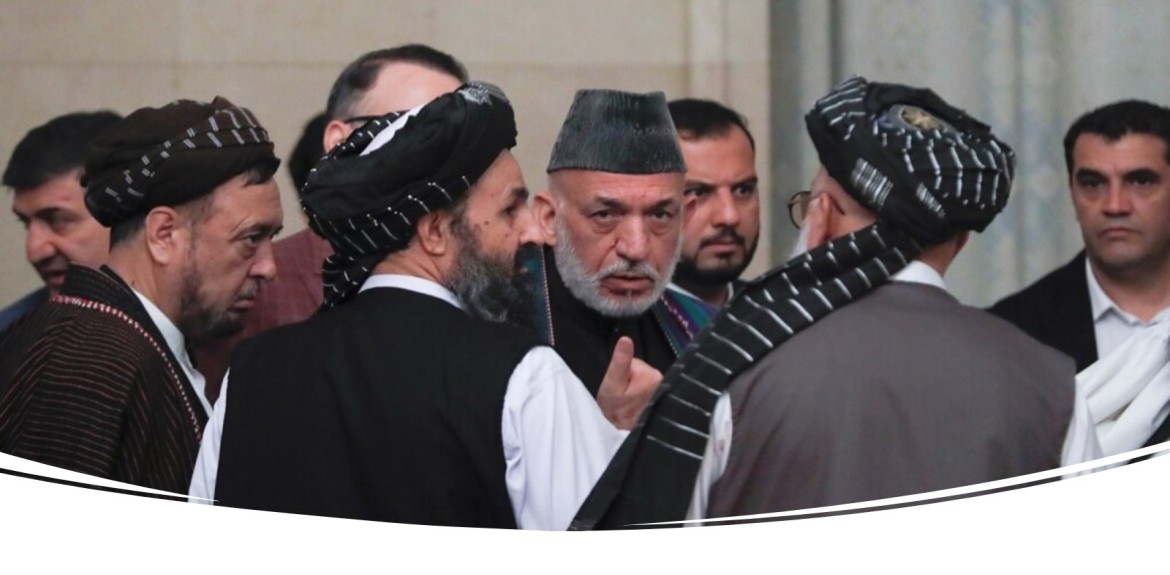Expecting lasting peace in the result of establishment of interim Afghan government is delusional.
Under the leadership of Zalmay Khalilzad, recent peace talks between the Taliban and the United States have sparked rumors about the possible structure of an interim administration and Afghanistan's future governance system. Although Khalilzad denied these rumors, questions remain about why they are circulating and what impact such discussions might have on achieving sustainable peace.
Over the past five years, interim governments have been established in various countries as mechanisms for political settlement and stability, but these initiatives have largely failed. In 2014, for instance, following the fall of Ukrainian President Viktor Yanukovych’s administration, an interim government was set up to end political discord and form a broad-based government. Instead, it failed to stabilize the country, leading to the loss of Crimea and the eruption of civil war in eastern Ukraine.
Similarly, in the Central African Republic, a transitional government was established in 2014 after prolonged conflict between former President François Bozizé’s supporters and coalition forces. However, the situation remained unresolved, eventually requiring the intervention of UN peacekeeping forces. In South Sudan, the peace-agreement-based interim government was repeatedly delayed, while in Thailand, following the ousting of Yingluck Shinawatra in 2014, the military's interim administration promised democratic reforms but failed to deliver until much later.
In Afghanistan, interim governments are not new. In 1992, the Mujahideen established an interim government in Peshawar, led by Sibghatullah Mojaddedi, after the withdrawal of Soviet forces. Intended to lead to a broad-based government, this effort devolved into civil conflict. Another interim government, created in 2001 under the Bonn Agreement and led by Hamid Karzai, marked Afghanistan's first experiment with power-sharing based on ethnic and factional quotas. This system, however, alienated major groups and entrenched rivalries, leaving deep divisions in Afghan society.
These interim governments of 1992 and 2001 in Afghanistan faced several similar challenges. Both were composed of factions, tribes, and ideologies that clashed over power, lacking the unity needed for effective governance. The 1992 Mujahideen government, for instance, excluded key groups, including Afghan Shia factions and the Rome-based exiled monarchy, leading to persistent power struggles. Similarly, in 2001, Taliban leaders sought to negotiate peace with Karzai’s interim administration but were rebuffed by the Northern Alliance, which pushed for a “catch and kill” strategy with U.S. backing.
The lack of cohesion in both governments prevented them from achieving crucial goals such as broad-based governance, transitional justice, sustainable peace, and democracy. Consequently, Afghanistan continued to suffer from civil conflict, tyranny, and warlordism throughout the 1990s and beyond 2001.
Research indicates that post-conflict interim governments are typically formed to provide temporary legitimacy and immunity to conflicting parties. In Afghanistan, however, the establishment of such governments has often allowed exiled warlords and powerful figures to reemerge, setting back progress toward transitional justice and reform.
While theories in peace and conflict resolution suggest that interim governments serve as “bridges” between conflict and lasting peace, in practice, they are often dominated by those who were parties to the original conflict. The success of peace agreements requires unity and coordination within the government, a feat more feasible under an elected government that represents the majority rather than a fragmented interim administration. An interim government composed of competing ideologies and factions tends to focus on sectional, party, or ethnic interests rather than collective national goals.
True, lasting peace goes beyond ceasefires and peace agreements—it involves integrating ex-combatants into the national army, providing them with employment and economic opportunities, releasing political prisoners, and creating truth and reconciliation commissions. Transitional justice, as well as reforms in the judiciary, legislature, and security sectors, is essential. Disarming and reintegrating former combatants into civilian life, along with addressing the psychological toll of war on the populace, are also critical steps.
At a recent meeting in Geneva, President Ghani asserted that Afghanistan could achieve lasting peace within five years. Some claim that because the Taliban refuse to join the current government, an interim administration should be established and elections postponed. Yet, if the Taliban genuinely sought peace, they could have accepted the president's unconditional peace offers over the years. Although Khalilzad set deadlines for the Taliban to negotiate before the presidential election, the group was either slow to respond or failed to seize the opportunity.
For Afghanistan, a stable and enduring peace will likely require a comprehensive, inclusive approach under a unified government, rather than through the fragmented structure of an interim administration.

